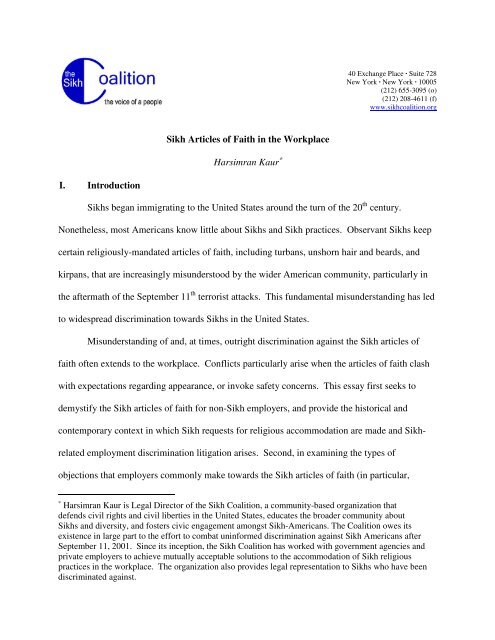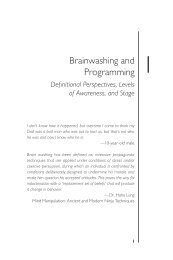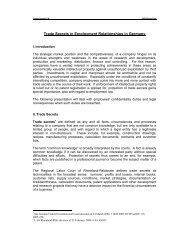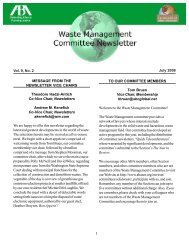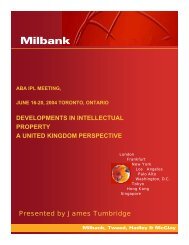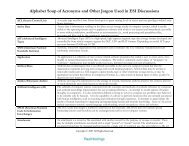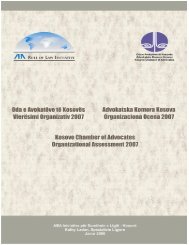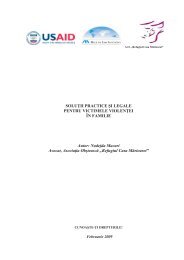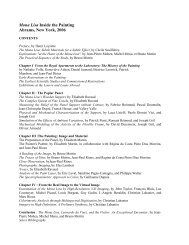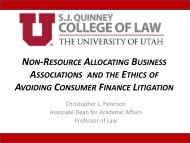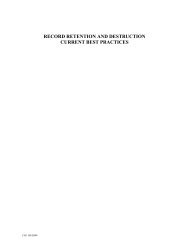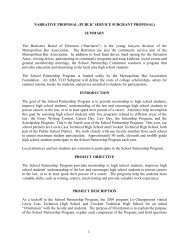Sikh Articles of Faith in the Workplace - American Bar Association
Sikh Articles of Faith in the Workplace - American Bar Association
Sikh Articles of Faith in the Workplace - American Bar Association
Create successful ePaper yourself
Turn your PDF publications into a flip-book with our unique Google optimized e-Paper software.
I. Introduction<br />
<strong>Sikh</strong> <strong>Articles</strong> <strong>of</strong> <strong>Faith</strong> <strong>in</strong> <strong>the</strong> <strong>Workplace</strong><br />
Harsimran Kaur ∗<br />
40 Exchange Place · Suite 728<br />
New York · New York · 10005<br />
(212) 655-3095 (o)<br />
(212) 208-4611 (f)<br />
www.sikhcoalition.org<br />
<strong>Sikh</strong>s began immigrat<strong>in</strong>g to <strong>the</strong> United States around <strong>the</strong> turn <strong>of</strong> <strong>the</strong> 20 th century.<br />
None<strong>the</strong>less, most <strong>American</strong>s know little about <strong>Sikh</strong>s and <strong>Sikh</strong> practices. Observant <strong>Sikh</strong>s keep<br />
certa<strong>in</strong> religiously-mandated articles <strong>of</strong> faith, <strong>in</strong>clud<strong>in</strong>g turbans, unshorn hair and beards, and<br />
kirpans, that are <strong>in</strong>creas<strong>in</strong>gly misunderstood by <strong>the</strong> wider <strong>American</strong> community, particularly <strong>in</strong><br />
<strong>the</strong> aftermath <strong>of</strong> <strong>the</strong> September 11 th terrorist attacks. This fundamental misunderstand<strong>in</strong>g has led<br />
to widespread discrim<strong>in</strong>ation towards <strong>Sikh</strong>s <strong>in</strong> <strong>the</strong> United States.<br />
Misunderstand<strong>in</strong>g <strong>of</strong> and, at times, outright discrim<strong>in</strong>ation aga<strong>in</strong>st <strong>the</strong> <strong>Sikh</strong> articles <strong>of</strong><br />
faith <strong>of</strong>ten extends to <strong>the</strong> workplace. Conflicts particularly arise when <strong>the</strong> articles <strong>of</strong> faith clash<br />
with expectations regard<strong>in</strong>g appearance, or <strong>in</strong>voke safety concerns. This essay first seeks to<br />
demystify <strong>the</strong> <strong>Sikh</strong> articles <strong>of</strong> faith for non-<strong>Sikh</strong> employers, and provide <strong>the</strong> historical and<br />
contemporary context <strong>in</strong> which <strong>Sikh</strong> requests for religious accommodation are made and <strong>Sikh</strong>-<br />
related employment discrim<strong>in</strong>ation litigation arises. Second, <strong>in</strong> exam<strong>in</strong><strong>in</strong>g <strong>the</strong> types <strong>of</strong><br />
objections that employers commonly make towards <strong>the</strong> <strong>Sikh</strong> articles <strong>of</strong> faith (<strong>in</strong> particular,<br />
∗ Harsimran Kaur is Legal Director <strong>of</strong> <strong>the</strong> <strong>Sikh</strong> Coalition, a community-based organization that<br />
defends civil rights and civil liberties <strong>in</strong> <strong>the</strong> United States, educates <strong>the</strong> broader community about<br />
<strong>Sikh</strong>s and diversity, and fosters civic engagement amongst <strong>Sikh</strong>-<strong>American</strong>s. The Coalition owes its<br />
existence <strong>in</strong> large part to <strong>the</strong> effort to combat un<strong>in</strong>formed discrim<strong>in</strong>ation aga<strong>in</strong>st <strong>Sikh</strong> <strong>American</strong>s after<br />
September 11, 2001. S<strong>in</strong>ce its <strong>in</strong>ception, <strong>the</strong> <strong>Sikh</strong> Coalition has worked with government agencies and<br />
private employers to achieve mutually acceptable solutions to <strong>the</strong> accommodation <strong>of</strong> <strong>Sikh</strong> religious<br />
practices <strong>in</strong> <strong>the</strong> workplace. The organization also provides legal representation to <strong>Sikh</strong>s who have been<br />
discrim<strong>in</strong>ated aga<strong>in</strong>st.
<strong>Sikh</strong> <strong>Articles</strong> <strong>of</strong> <strong>Faith</strong> <strong>in</strong> <strong>the</strong> <strong>Workplace</strong><br />
turbans, beards, and kirpans), this essay seeks to m<strong>in</strong>imize conflict and promote accommodation<br />
<strong>of</strong> <strong>the</strong> <strong>Sikh</strong> articles <strong>of</strong> faith <strong>in</strong> <strong>the</strong> workplace.<br />
II. <strong>Sikh</strong>ism and <strong>the</strong> <strong>Sikh</strong> <strong>Articles</strong> <strong>of</strong> <strong>Faith</strong><br />
The <strong>Sikh</strong> religion is a mono<strong>the</strong>istic religion that orig<strong>in</strong>ated <strong>in</strong> <strong>the</strong> late fifteenth century <strong>in</strong><br />
<strong>the</strong> northwestern area <strong>of</strong> South Asia that is known today as Punjab. It is a dist<strong>in</strong>ct and<br />
<strong>in</strong>dependent religion and is not affiliated with any o<strong>the</strong>r religion. With over 20 million followers<br />
worldwide, <strong>Sikh</strong>ism is <strong>the</strong> fifth largest religion <strong>in</strong> <strong>the</strong> world today. 1<br />
On or about April 14, 1699, <strong>the</strong> tenth <strong>Sikh</strong> Guru 2 decreed that <strong>Sikh</strong>s should take amrit (be<br />
<strong>in</strong>itiated <strong>in</strong>to <strong>the</strong> <strong>Sikh</strong> faith), and keep five articles <strong>of</strong> faith. S<strong>in</strong>ce that time, <strong>Sikh</strong>s have been<br />
required, as a matter <strong>of</strong> religious belief and practice, to take amrit and ma<strong>in</strong>ta<strong>in</strong> five articles <strong>of</strong><br />
faith on or as part <strong>of</strong> <strong>the</strong>ir person. The five articles <strong>of</strong> faith start with <strong>the</strong> Punjabi letter for “K”,<br />
and are <strong>the</strong>reby <strong>in</strong>formally referred to as “<strong>the</strong> Five K's.” They are Kes 3 (unshorn hair), Kangha 4<br />
(comb), Kara 5 (steel bracelet), Kirpan 6 (sword), and Kacch 7 (undergarment). The <strong>Sikh</strong> Code <strong>of</strong><br />
Conduct, called <strong>the</strong> Rehat Maryada, also requires that practic<strong>in</strong>g <strong>Sikh</strong>s keep <strong>the</strong> Five K’s and<br />
1<br />
See Neil MacFarqhar, Airport Scrut<strong>in</strong>y <strong>of</strong> Headgear Raises Bias Claims From <strong>Sikh</strong>s, NYTimes, August<br />
30, 2007, available onl<strong>in</strong>e at http://www.sikhcoalition.org/advisories/documents/NYT-<br />
HeadgearRaisesBiasClaimsFrom<strong>Sikh</strong>s.pdf (last checked August 11, 2008).<br />
2<br />
The term “Guru” means “Enlightener.” In <strong>Sikh</strong>ism <strong>the</strong>re were a total <strong>of</strong> ten liv<strong>in</strong>g Gurus, all <strong>of</strong> whom<br />
are considered “prophets,” or direct messengers for a higher transcendental power. See also Kapur S<strong>in</strong>gh,<br />
<strong>Sikh</strong>ism for <strong>the</strong> Modern Man, 4 th ed., Amritsar: Guru Nanak Dev University, 2000, p. 34.<br />
3<br />
Guru Nanak, <strong>the</strong> founder <strong>of</strong> <strong>the</strong> <strong>Sikh</strong> faith, started <strong>the</strong> practice <strong>of</strong> keep<strong>in</strong>g hair unshorn because keep<strong>in</strong>g<br />
it <strong>in</strong> a natural state is regarded as liv<strong>in</strong>g <strong>in</strong> harmony with <strong>the</strong> will <strong>of</strong> God.<br />
4<br />
The kangha is a small comb that can be worn easily <strong>in</strong> <strong>the</strong> hair at all times and is a symbol <strong>of</strong><br />
cleanl<strong>in</strong>ess. Just as a comb helps to remove <strong>the</strong> tangles and cleans <strong>the</strong> hair, <strong>the</strong> kangha is a spiritual<br />
rem<strong>in</strong>der to shed impurities <strong>of</strong> thought.<br />
5<br />
The kara is worn to rem<strong>in</strong>d a <strong>Sikh</strong> that he or she is a servant <strong>of</strong> <strong>the</strong> Guru and should not do anyth<strong>in</strong>g that<br />
may br<strong>in</strong>g shame or disgrace.<br />
6<br />
The kirpan is a religious sword that encapsulates an <strong>in</strong>itiated <strong>Sikh</strong>'s solemn obligation <strong>of</strong> courage and<br />
self-defense. It denotes dignity, self-reliance, and <strong>the</strong> capacity and read<strong>in</strong>ess to always defend <strong>the</strong> weak<br />
and <strong>the</strong> oppressed. It helps susta<strong>in</strong> one's martial spirit and <strong>the</strong> determ<strong>in</strong>ation to sacrifice oneself <strong>in</strong> order to<br />
defend truth, oppression, and <strong>Sikh</strong> moral values. All <strong>in</strong>itiated <strong>Sikh</strong>s are mandated to carry a kirpan on<br />
<strong>the</strong>ir body.<br />
7<br />
A special, slightly longer type <strong>of</strong> shorts, <strong>the</strong> kachh is l<strong>in</strong>ked to a high moral character and must be worn<br />
at all times. It rem<strong>in</strong>ds <strong>the</strong> <strong>Sikh</strong> <strong>of</strong> <strong>the</strong> need for self-restra<strong>in</strong> over passions and desires.<br />
2
<strong>Sikh</strong> <strong>Articles</strong> <strong>of</strong> <strong>Faith</strong> <strong>in</strong> <strong>the</strong> <strong>Workplace</strong><br />
enjo<strong>in</strong>s <strong>Sikh</strong> men and women to cover <strong>the</strong>ir heads at all times. 8 All <strong>Sikh</strong> men wear a turban 9 ;<br />
<strong>Sikh</strong> women sometimes wear a turban and <strong>of</strong>ten cover <strong>the</strong>ir head with a scarf.<br />
The articles <strong>of</strong> faith (<strong>the</strong> 5 K’s and <strong>the</strong> turban) are physical manifestations <strong>of</strong> core <strong>Sikh</strong><br />
spiritual values, rem<strong>in</strong>d<strong>in</strong>g <strong>the</strong>ir bearer that her actions should be consistent with her beliefs.<br />
They are an external uniform that unifies <strong>Sikh</strong>s, b<strong>in</strong>ds <strong>the</strong>m to <strong>the</strong> beliefs <strong>of</strong> <strong>the</strong> religion, and<br />
rem<strong>in</strong>ds <strong>the</strong>m <strong>of</strong> <strong>the</strong>ir commitment to <strong>the</strong> <strong>Sikh</strong> Gurus at all times. On a personal level, <strong>the</strong>y<br />
represent a physical discipl<strong>in</strong>e that helps <strong>Sikh</strong>s to ma<strong>in</strong>ta<strong>in</strong> <strong>the</strong>ir spiritual discipl<strong>in</strong>e. In <strong>the</strong><br />
societal sphere, <strong>the</strong>y are mark<strong>in</strong>gs which identify a person as a follower <strong>of</strong> <strong>the</strong> way <strong>of</strong> life<br />
revealed to <strong>the</strong> <strong>Sikh</strong> gurus and are an exteriorization <strong>of</strong> <strong>the</strong> mission given to <strong>Sikh</strong>s.<br />
S<strong>in</strong>ce faith is largely personal, one will likely to hear different shades <strong>of</strong> answers from<br />
different <strong>Sikh</strong>s about what <strong>the</strong>se articles mean. At m<strong>in</strong>imum, <strong>the</strong>y b<strong>in</strong>d <strong>the</strong> <strong>Sikh</strong> to <strong>the</strong>ir Guru <strong>in</strong><br />
an <strong>in</strong>explicable relationship <strong>of</strong> love and faith. Unlike some o<strong>the</strong>r faiths where only <strong>the</strong> clergy are<br />
<strong>in</strong> uniform, all <strong>Sikh</strong>s are enjo<strong>in</strong>ed to wear <strong>the</strong> uniform <strong>of</strong> <strong>the</strong>ir beliefs. The obligation <strong>of</strong> <strong>Sikh</strong>s to<br />
keep <strong>the</strong> articles <strong>of</strong> faith is a cornerstone <strong>of</strong> <strong>the</strong> <strong>Sikh</strong> religion and is commonly viewed by<br />
members <strong>of</strong> <strong>the</strong> <strong>Sikh</strong> faith to be among <strong>the</strong> central requirements <strong>of</strong> <strong>the</strong> <strong>Sikh</strong> religion. 10<br />
8 The Panthic Rehat Maryada (<strong>Sikh</strong> Code <strong>of</strong> Conduct), Official English Translation <strong>of</strong> <strong>the</strong> Shiromani<br />
Gurdwara Parbandhak Committee, available onl<strong>in</strong>e at http://www.sgpc.net/sikhism/sikh-dharmamanual.asp<br />
(last checked January 16, 2008).<br />
9 The turban it has immense spiritual and temporal significance. Wear<strong>in</strong>g a turban declares sovereignty,<br />
dedication, self-respect, courage and piety. <strong>Sikh</strong>s consider <strong>the</strong> turban to be a precious gift from <strong>the</strong>ir<br />
Guru and many wash <strong>the</strong>ir hands before <strong>the</strong>y beg<strong>in</strong> to tie it. When a <strong>Sikh</strong> ties a turban, <strong>the</strong> turban ceases<br />
to be just a piece <strong>of</strong> cloth and becomes one and <strong>the</strong> same with <strong>the</strong> <strong>Sikh</strong>'s head. Generally speak<strong>in</strong>g, “[f]or<br />
<strong>Sikh</strong>s, to <strong>in</strong> any way remove <strong>the</strong> turban <strong>in</strong> public or dur<strong>in</strong>g <strong>the</strong> course <strong>of</strong> <strong>the</strong>ir pr<strong>of</strong>essional duties,<br />
constitutes a most serious breach <strong>of</strong> <strong>the</strong> <strong>Sikh</strong> code <strong>of</strong> conduct (rahit maryada). It is regarded as an act<br />
which disgraces <strong>the</strong> honor <strong>of</strong> <strong>the</strong> <strong>in</strong>dividual <strong>Sikh</strong> and <strong>the</strong> wider <strong>Sikh</strong> community.” Arv<strong>in</strong>d-Pal S<strong>in</strong>gh<br />
Mandair (Ph.D), Expert Report Prepared for Pla<strong>in</strong>tiff <strong>in</strong> Rathour v. New York City Police Dept., pg 11.<br />
10 Kapur S<strong>in</strong>gh, Me Judice, Amritsar: B. Chattar S<strong>in</strong>gh Jiwan S<strong>in</strong>gh, 2003, p. 258-264.<br />
3
<strong>Sikh</strong> <strong>Articles</strong> <strong>of</strong> <strong>Faith</strong> <strong>in</strong> <strong>the</strong> <strong>Workplace</strong><br />
III. History <strong>of</strong> <strong>Sikh</strong> Migration to <strong>the</strong> United States<br />
<strong>Sikh</strong>s first migrated from <strong>the</strong> Punjab region <strong>of</strong> India to <strong>the</strong> United States <strong>in</strong> <strong>the</strong> early<br />
1900’s, arriv<strong>in</strong>g <strong>in</strong> British Columbia, Canada, <strong>in</strong> 1902. 11 From Canada <strong>the</strong>y migrated south,<br />
settl<strong>in</strong>g <strong>in</strong> <strong>the</strong> states <strong>of</strong> California, Oregon and Wash<strong>in</strong>gton. Accord<strong>in</strong>g to N. Gerald <strong>Bar</strong>rier, a<br />
pr<strong>of</strong>essor <strong>of</strong> <strong>Sikh</strong> Studies at <strong>the</strong> University <strong>of</strong> Wiscons<strong>in</strong>, when this group <strong>of</strong> immigrants first<br />
arrived <strong>in</strong> <strong>the</strong> United States, “[t]he numbers were not large, but <strong>the</strong> specter <strong>of</strong> a ‘H<strong>in</strong>du’ or<br />
‘turban’ tide, when comb<strong>in</strong>ed with <strong>the</strong> current racial attitudes and fears about Asian immigrants<br />
as a whole, caused a backlash and led to a series <strong>of</strong> adm<strong>in</strong>istrative and legislative measures that<br />
put . . . limits on future migration dur<strong>in</strong>g <strong>the</strong> second decade <strong>of</strong> <strong>the</strong> century.” 12<br />
By <strong>the</strong> 1960’s, however, a second wave <strong>of</strong> <strong>Sikh</strong> immigrants from Punjab arrived on <strong>the</strong><br />
eastern coast <strong>of</strong> <strong>the</strong> United States, tak<strong>in</strong>g positions <strong>of</strong> employment mostly <strong>in</strong> <strong>the</strong> fields <strong>of</strong><br />
medic<strong>in</strong>e, science, and bus<strong>in</strong>ess. In addition, <strong>in</strong> <strong>the</strong> 1960’s and early 70’s, a number <strong>of</strong><br />
Caucasian and o<strong>the</strong>r <strong>American</strong>s converted to <strong>Sikh</strong>ism. A third wave <strong>of</strong> <strong>Sikh</strong> immigrants arrived<br />
<strong>in</strong> <strong>the</strong> United States <strong>in</strong> <strong>the</strong> 1980’s and 1990’s, partly as a result <strong>of</strong> political conflict <strong>in</strong> <strong>the</strong>ir<br />
homeland <strong>of</strong> Punjab. These immigrants have taken a variety <strong>of</strong> employment positions, rang<strong>in</strong>g<br />
from day laborers and taxi drivers to <strong>in</strong>formation technology consultants. Today, approximately<br />
500,000 <strong>Sikh</strong> <strong>American</strong>s reside <strong>in</strong> <strong>the</strong> United States. 13<br />
In <strong>the</strong> aftermath <strong>of</strong> <strong>the</strong> tragic events <strong>of</strong> September 11, 2001, <strong>Sikh</strong>s across <strong>the</strong> country<br />
were subject to a variety <strong>of</strong> forms <strong>of</strong> discrim<strong>in</strong>ation and harassment that was largely based on a<br />
mistaken perception that <strong>the</strong>y are <strong>of</strong> Arab or Muslim background or are related to <strong>the</strong> Al Quaeda<br />
11 N. Gerald <strong>Bar</strong>rier, “<strong>Sikh</strong> Emigrants and <strong>the</strong> Homeland: The Transmission <strong>of</strong> Information, Resources<br />
and Values <strong>in</strong> <strong>the</strong> Early Twentieth Century”ch.3 <strong>in</strong> The <strong>Sikh</strong> Diaspora, <strong>Bar</strong>rier & Dusenbery, Chanakya,,<br />
p. 69.<br />
12 Id.<br />
13 Senate Congressional Resolution 74, 107 th Congress, 1 st Session, (October 2, 2001).<br />
4
<strong>Sikh</strong> <strong>Articles</strong> <strong>of</strong> <strong>Faith</strong> <strong>in</strong> <strong>the</strong> <strong>Workplace</strong><br />
terrorist network. 14 Relative to o<strong>the</strong>r vulnerable m<strong>in</strong>orities, <strong>Sikh</strong>s have been disproportionately<br />
targeted for discrim<strong>in</strong>ation because <strong>the</strong>y wear turbans and keep unshorn hair (<strong>in</strong>clud<strong>in</strong>g facial<br />
hair) <strong>in</strong> accordance with <strong>the</strong>ir faith. 15 <strong>Sikh</strong>s have been subject to various forms <strong>of</strong> discrim<strong>in</strong>ation<br />
<strong>in</strong>clud<strong>in</strong>g illegal pr<strong>of</strong>il<strong>in</strong>g by law enforcement authorities, <strong>the</strong> commission <strong>of</strong> hate crimes by<br />
civilians (<strong>in</strong>clud<strong>in</strong>g fatalities), and employment discrim<strong>in</strong>ation. 16<br />
IV. The Accommodation <strong>of</strong> <strong>Sikh</strong> <strong>Articles</strong> <strong>of</strong> <strong>Faith</strong> <strong>in</strong> <strong>the</strong> <strong>Workplace</strong><br />
The <strong>Sikh</strong> articles <strong>of</strong> faith that are most <strong>of</strong>ten <strong>the</strong> subject <strong>of</strong> controversy <strong>in</strong> <strong>the</strong> workplace<br />
are turbans, beards, and kirpans. When a <strong>Sikh</strong> makes a religion-based request for<br />
accommodation <strong>of</strong> a turban, beard, or kirpan, <strong>the</strong> employer’s response <strong>of</strong>ten turns on whe<strong>the</strong>r<br />
<strong>the</strong>re is someth<strong>in</strong>g about <strong>the</strong> article that ei<strong>the</strong>r:<br />
• ostensibly prevents a person from do<strong>in</strong>g his/her job, or<br />
• presents a special danger to <strong>the</strong> employee or workplace that would not o<strong>the</strong>rwise exist.<br />
A. Overcom<strong>in</strong>g Image-Based Objections to <strong>Sikh</strong> Turbans and Beards<br />
There are few circumstances <strong>in</strong> which a turban or beard actually prevents a <strong>Sikh</strong><br />
employee from do<strong>in</strong>g his or her job. Many employers’ objections are image or appearance-based<br />
– <strong>in</strong> o<strong>the</strong>r words, based upon Western cultural values associated with groom<strong>in</strong>g, e.g., that<br />
headwear should not be worn <strong>in</strong>doors and that be<strong>in</strong>g clean-shaven is preferable to grow<strong>in</strong>g a<br />
beard. 17 Often, employers deny a request for accommodation <strong>of</strong> a <strong>Sikh</strong> turban or beard under <strong>the</strong><br />
rubric <strong>of</strong> “customer preference,” a preference that aga<strong>in</strong> relies upon Western notions <strong>of</strong> groom<strong>in</strong>g<br />
14<br />
Human Rights Watch, We Are Not The Enemy: Hate Crimes Aga<strong>in</strong>st Arabs, Muslims, and Those<br />
Perceived to be Arab or Muslim after September 11 Vol. 14, No. 6(G), p. 14 (Nov. 2002) (“HRW<br />
Report”).<br />
15 th st<br />
Senate Congressional Resolution 74, 107 Congress, 1 Session, (October 2, 2001).<br />
16<br />
HRW Report, pp. 17-20.<br />
17<br />
Indeed, <strong>the</strong> idea that wear<strong>in</strong>g a religious article is <strong>in</strong>tr<strong>in</strong>sically tied to one’s faith is foreign to most<br />
Westerners – until one po<strong>in</strong>ts out that <strong>the</strong> clergy <strong>of</strong> most Western faiths wear special cloth<strong>in</strong>g or articles<br />
as part <strong>of</strong> <strong>the</strong>ir worship.<br />
5
<strong>Sikh</strong> <strong>Articles</strong> <strong>of</strong> <strong>Faith</strong> <strong>in</strong> <strong>the</strong> <strong>Workplace</strong><br />
and propriety. Courts sometimes are persuaded by that customer preference places an undue<br />
hardship on an employer to accommodate a <strong>Sikh</strong> turban or beard. For example, EEOC v.<br />
Sambo’s <strong>of</strong> Georgia upheld a restaurant’s refusal to hire a bearded <strong>Sikh</strong> as a manager and found<br />
that that be<strong>in</strong>g cleanshaven was a bona fide occupational qualification for a family restaurant,<br />
given customer preference. 530 F. Supp. 86 (N.D.Ga. 1981). See also Ali v. Alamo Rent-A-<br />
Car, Inc., 8 Fed.Appx. 156, 2001 WL 218788 (C.A.4 2001) (f<strong>in</strong>d<strong>in</strong>g that <strong>the</strong> employer’s<br />
transferal <strong>of</strong> a Muslim to a position without customer contact because she wore a headscarf was<br />
not an adverse employment action).<br />
Image or appearance-based objections are exacerbated where <strong>the</strong> requested<br />
accommodation conflicts with an employer’s uniform or groom<strong>in</strong>g policy. One example is Birdi<br />
v. UAL Corp. which upheld an airl<strong>in</strong>e’s term<strong>in</strong>ation <strong>of</strong> a <strong>Sikh</strong> customer service representative<br />
whose turban conflicted with a “no headwear” policy, and found that <strong>the</strong> airl<strong>in</strong>e met its burden to<br />
accommodate by <strong>of</strong>fer<strong>in</strong>g <strong>the</strong> <strong>Sikh</strong> o<strong>the</strong>r positions without face-to-face customer contact <strong>in</strong><br />
which he could wear his turban. No. 99 C 5576, W.L 471999 (N.D.Ill. 2002). Employers <strong>of</strong>ten<br />
refuse to hire <strong>Sikh</strong>s when a “no beard” policy exists, for example, for car salesmen and law<br />
enforcement positions. See, e.g., section IV(B) below and fn. 19.<br />
Not all courts accept “customer preference” or image-based objections as evidence <strong>of</strong><br />
undue hardship justify<strong>in</strong>g a refusal to accommodate a turban or beard. Kohli v. LOOC, INC.<br />
rejected Dom<strong>in</strong>oes pizza cha<strong>in</strong>’s claim that hir<strong>in</strong>g a bearded <strong>Sikh</strong> as a manager would present an<br />
undue hardship despite <strong>the</strong> employer’s pr<strong>of</strong>fered evidence <strong>of</strong> customer distaste for bearded<br />
employees and employees wear<strong>in</strong>g beard nets. 347 Md. 258, 701 A.2d 92 (1995), appealed on<br />
o<strong>the</strong>r grounds, 103 Md.App. 694, 654 A.2d 922 (1996).<br />
6
<strong>Sikh</strong> <strong>Articles</strong> <strong>of</strong> <strong>Faith</strong> <strong>in</strong> <strong>the</strong> <strong>Workplace</strong><br />
Government agencies that enforce federal anti-discrim<strong>in</strong>ation law are tak<strong>in</strong>g a stance<br />
aga<strong>in</strong>st image or appearance-based objections to <strong>the</strong> <strong>Sikh</strong> articles <strong>of</strong> faith. For example, <strong>in</strong> 2005<br />
<strong>the</strong> U.S. Department <strong>of</strong> Justice (“DOJ”) filed an employment discrim<strong>in</strong>ation lawsuit aga<strong>in</strong>st <strong>the</strong><br />
Metropolitan Transit Authority <strong>of</strong> New York (“MTA”) for forc<strong>in</strong>g five <strong>Sikh</strong> station agents and<br />
one subway tra<strong>in</strong> operator (as well Muslim bus drivers) to brand <strong>the</strong>ir religious headwear with an<br />
MTA logo. (The <strong>Sikh</strong> Coalition, a civil rights organization, also filed lawsuits on behalf <strong>of</strong> <strong>the</strong><br />
<strong>Sikh</strong> employees.) MTA <strong>in</strong>itially told <strong>the</strong> <strong>Sikh</strong> employees that <strong>the</strong>y would have to ei<strong>the</strong>r remove<br />
<strong>the</strong>ir turbans or be reassigned to less desirable positions <strong>in</strong> <strong>the</strong> rail yards outside <strong>of</strong> customer<br />
view. It <strong>the</strong>n withdrew this stance and <strong>in</strong>stead <strong>in</strong>stituted <strong>the</strong> turban-brand<strong>in</strong>g policy – despite <strong>the</strong><br />
fact that not all <strong>of</strong> its uniform headwear conta<strong>in</strong>ed an MTA logo. It also discrim<strong>in</strong>atorily<br />
enforced <strong>the</strong> headwear aspect <strong>of</strong> its uniform policy. The U.S. Department <strong>of</strong> Justice (“DOJ”)<br />
conducted an <strong>in</strong>vestigation <strong>in</strong>to <strong>the</strong> allegations <strong>of</strong> discrim<strong>in</strong>ation and found over 200 <strong>in</strong>stances <strong>of</strong><br />
MTA employees wear<strong>in</strong>g headwear without an MTA logo (e.g., Yankees baseball caps, etc.)<br />
over <strong>the</strong> course <strong>of</strong> three days. 18<br />
The DOJ is not <strong>the</strong> only federal agency that has taken a stance aga<strong>in</strong>st image or<br />
appearance based discrim<strong>in</strong>ation. The U.S. Equal Employment Opportunity’s (“EEOC”) newly<br />
revised Compliance Manual (“Compl. Man’l.”) directly advises aga<strong>in</strong>st employers’ use <strong>of</strong><br />
customer preference as a basis for tak<strong>in</strong>g action. “If an employer takes an action based on <strong>the</strong><br />
discrim<strong>in</strong>atory preferences <strong>of</strong> o<strong>the</strong>rs, <strong>in</strong>clud<strong>in</strong>g co-workers or clients, <strong>the</strong> employer is unlawfully<br />
discrim<strong>in</strong>at<strong>in</strong>g.” EEOC Compl. Man’l. § 12-II(B), rev. 7/22/08. 19 In addition,<br />
18 The MTA also asserted a safety <strong>in</strong> recognizability argument <strong>in</strong> defend<strong>in</strong>g <strong>the</strong>ir turban-brand<strong>in</strong>g policy.<br />
They argued that, <strong>in</strong> a post-9/11 world, it was imperative for <strong>Sikh</strong>s and Muslims wear<strong>in</strong>g religious<br />
headwear to be recognizable as MTA employees. O<strong>the</strong>rwise, customers would be confused <strong>in</strong> an<br />
emergency. For additional discussion about safety <strong>in</strong> recognizability, see section IV(B).<br />
19 The religion section <strong>of</strong> <strong>the</strong> EEOC Compliance Manual is available onl<strong>in</strong>e at<br />
http://www.eeoc.gov/policy/docs/religion.html (last checked August 9, 2008).<br />
7
<strong>Sikh</strong> <strong>Articles</strong> <strong>of</strong> <strong>Faith</strong> <strong>in</strong> <strong>the</strong> <strong>Workplace</strong><br />
[a]bsent undue hardship, religious discrim<strong>in</strong>ation may be found where an<br />
employer fails to accommodate <strong>the</strong> employee’s religious dress or groom<strong>in</strong>g<br />
practices…. While <strong>the</strong>re may be circumstances <strong>in</strong> which allow<strong>in</strong>g a particular<br />
exception to an employer’s dress and groom<strong>in</strong>g policy would pose an undue<br />
hardship, an employer’s reliance on <strong>the</strong> broad rubric <strong>of</strong> “image” to deny a<br />
requested religious accommodation may <strong>in</strong> a given case be tantamount to reliance<br />
on customer religious bias (so-called “customer preference”) <strong>in</strong> violation <strong>of</strong> Title<br />
VII.<br />
Id. at §12-IV(C)(4)(a).<br />
Where <strong>Sikh</strong>s’ turbans and beards do not prevent <strong>the</strong>m from do<strong>in</strong>g <strong>the</strong>ir job, employers’<br />
refusal to accommodate <strong>Sikh</strong> articles <strong>of</strong> faith is <strong>in</strong> direct contravention to <strong>the</strong> <strong>in</strong>tegrative purposes<br />
<strong>of</strong> state and federal anti-discrim<strong>in</strong>ation laws. Employers <strong>the</strong>refore will open <strong>the</strong>mselves to<br />
liability <strong>in</strong> <strong>in</strong>stances where uniform and groom<strong>in</strong>g policies or customer preference are <strong>the</strong> only<br />
reasons for refus<strong>in</strong>g to provide a religion-based accommodation to a <strong>Sikh</strong>. 20<br />
B. Safety-Based Objections to Turbans and Beards Must be Real<br />
In some <strong>in</strong>stances, employers fail to accommodate <strong>Sikh</strong> employees’ religious practices<br />
because <strong>of</strong> safety considerations. Safety is obviously a persuasive reason for <strong>the</strong> denial <strong>of</strong><br />
accommodation <strong>of</strong> turbans or beards. See, e.g., Bhatia v. Chevron, 734 F.2d 1382 (9 th Cir. 1984)<br />
(f<strong>in</strong>d<strong>in</strong>g undue hardship where an employer refused to accommodate a <strong>Sikh</strong>’s unshorn beard<br />
because it prevented <strong>the</strong> employee from wear<strong>in</strong>g a respirator that formed an airtight seal allow<strong>in</strong>g<br />
potential exposure to toxic gas); Kalsi v. New York City Transit Authority, 62 F.Supp.2d 745<br />
20 Federal, state, and local governments must also abide by <strong>the</strong> Constitution and, <strong>in</strong> <strong>the</strong> federal<br />
government’s case, <strong>the</strong> Religious Freedom Restoration Act (“RFRA”), <strong>in</strong> consider<strong>in</strong>g how <strong>the</strong>ir actions<br />
may affect <strong>Sikh</strong>s <strong>in</strong> <strong>the</strong> workplace. The <strong>Sikh</strong> Coalition is currently settl<strong>in</strong>g an image-based case brought<br />
under <strong>the</strong> First Amendment and RFRA aga<strong>in</strong>st <strong>the</strong> Federal Protective Service (“FPS”), a federal agency<br />
that provides security guard services to federal facilities. FPS refused to accommodate a <strong>Sikh</strong> contract<br />
security guard’s turban and beard – despite <strong>the</strong> fact that medical and o<strong>the</strong>r secular exemptions to its “no<br />
beard” requirement existed. FPS ultimately agreed to change its groom<strong>in</strong>g and uniform policy to allow<br />
<strong>Sikh</strong>s to serve as contract FPS guards with <strong>the</strong>ir articles <strong>of</strong> faith <strong>in</strong>tact. See also Fraternal Order <strong>of</strong> Police<br />
v. City <strong>of</strong> Newark, 170 F.3d 359 (3 rd Cir. 1999) (hold<strong>in</strong>g that a police department’s refusal to provide<br />
Muslim police <strong>of</strong>ficers with an exemption to a “no beard” policy for religious reasons, while allow<strong>in</strong>g<br />
medical exemptions, was suggestive <strong>of</strong> discrim<strong>in</strong>atory <strong>in</strong>tent, trigger<strong>in</strong>g heightened scrut<strong>in</strong>y analysis and<br />
violat<strong>in</strong>g <strong>the</strong> First Amendment).<br />
8
<strong>Sikh</strong> <strong>Articles</strong> <strong>of</strong> <strong>Faith</strong> <strong>in</strong> <strong>the</strong> <strong>Workplace</strong><br />
(E.D. N.Y. 1998) (f<strong>in</strong>d<strong>in</strong>g undue hardship to accommodate a <strong>Sikh</strong> car <strong>in</strong>spector’s turban which<br />
conflicted with a mandatory hard hat policy <strong>in</strong> <strong>the</strong> face <strong>of</strong> actual evidence <strong>of</strong> a safety threat).<br />
Courts and pla<strong>in</strong>tiffs, however, will push employers to justify whe<strong>the</strong>r such safety objections are<br />
perceived or are real. Employers must provide evidence <strong>of</strong> actual threats to safety that support<br />
<strong>the</strong>ir denial <strong>of</strong> religion-based accommodations.<br />
The Jaggi case is particularly illustrative. See Jaggi v. Police Dep’t, OATH Index No.<br />
1498/03 (Apr. 28, 2004), aff'd , Comm'n Dec. (June 29, 2004). 21 Through <strong>the</strong> decision, <strong>the</strong> New<br />
York City Commission on Human Rights forced <strong>the</strong> New York City Police Department<br />
(“NYPD”) to allow a <strong>Sikh</strong> to serve as a Traffic Enforcement Agent – Level II (“TEA”) with his<br />
turban. (TEA’s direct traffic and issue summonses.) The NYPD had denied Mr. Jaggi’s<br />
repeated requests for accommodation and had constructively discharged him when he began<br />
wear<strong>in</strong>g his religiously-mandated turban to work <strong>in</strong>stead <strong>of</strong> <strong>the</strong> required uniform white eight-<br />
po<strong>in</strong>t hat. The NYPD had also warned Mr. Jaggi that he would be required to trim his unshorn<br />
beard.<br />
The NYPD argued that it could not accommodate Mr. Jaggi’s articles <strong>of</strong> faith because <strong>of</strong><br />
two separate safety concerns, both <strong>of</strong> which <strong>the</strong> adm<strong>in</strong>istrative law judge (“ALJ”) rejected. First,<br />
<strong>the</strong> NYPD argued that it had a safety <strong>in</strong>terest <strong>in</strong> recognizability – that Mr. Jaggi would be<br />
unrecognizable as a TEA and member <strong>of</strong> <strong>the</strong> NYPD if he wore a turban <strong>in</strong>stead <strong>of</strong> <strong>the</strong> uniform<br />
hat, <strong>the</strong>refore compromis<strong>in</strong>g his safety. The NYPD pr<strong>of</strong>fered evidence that racial epi<strong>the</strong>ts and<br />
assaults on TEA’s had decreased when TEA uniform colors were changed to navy, match<strong>in</strong>g<br />
those <strong>of</strong> police <strong>of</strong>ficers and <strong>in</strong>creas<strong>in</strong>g TEA recognizability as members <strong>of</strong> <strong>the</strong> NYPD. The ALJ<br />
held, however, that although <strong>the</strong>re may have been a causal l<strong>in</strong>k between <strong>the</strong> lowered assault rate<br />
21 Available onl<strong>in</strong>e at http://search.citylaw.org/isysquery/1108becb-02b0-41eb-9e1a-<br />
5c7b41bc0703/3/doc/ (last checked August 11, 2008).<br />
9
<strong>Sikh</strong> <strong>Articles</strong> <strong>of</strong> <strong>Faith</strong> <strong>in</strong> <strong>the</strong> <strong>Workplace</strong><br />
and <strong>the</strong> color <strong>of</strong> <strong>the</strong> uniform, <strong>the</strong> NYPD had <strong>of</strong>fered no evidence <strong>of</strong> a l<strong>in</strong>k between assaults and<br />
<strong>the</strong> type <strong>of</strong> headwear worn by TEA’s. The NYPD’s assertion that <strong>the</strong> turban would pose a<br />
greater safety risk as compared to <strong>the</strong> uniform eight-po<strong>in</strong>t hat was speculative, particularly given<br />
that (a) Mr. Jaggi would wear <strong>the</strong> standard TEA uniform from <strong>the</strong> neck-down, and (b) TEA’s<br />
wore a nondescript black hat <strong>in</strong> <strong>the</strong> w<strong>in</strong>ter but ma<strong>in</strong>ta<strong>in</strong>ed <strong>the</strong>ir recognizability. In o<strong>the</strong>r words,<br />
<strong>the</strong> ALJ believed that Mr. Jaggi would be as recognizable as a TEA with his turban as compared<br />
to <strong>the</strong> uniform hat. Wear<strong>in</strong>g his turban posed him no greater danger than he would have<br />
o<strong>the</strong>rwise faced.<br />
The ALJ also rejected <strong>the</strong> NYPD second safety-based argument for deny<strong>in</strong>g Mr. Jaggi’s<br />
request for accommodation. The NYPD argued that Mr. Jaggi would be unable to use a gasmask<br />
or tactical escape hood <strong>in</strong> an emergency. The ALJ however accepted Mr. Jaggi’s testimony that<br />
he would remove his turban (just as any TEA would need to remove his or her hat) and let his<br />
long hair out <strong>of</strong> a bun (just as a female TEA may need to) <strong>in</strong> order to don emergency headwear.<br />
The ALJ also rejected <strong>the</strong> NYPD’s contention that Mr. Jaggi’s beard may prevent a gas mask<br />
from form<strong>in</strong>g a proper seal, rely<strong>in</strong>g on a previous case before <strong>the</strong> Commission on Human Rights<br />
which found no “evidence that a ‘flat twist’ <strong>of</strong> a Muslim correction <strong>of</strong>ficer’s beard to properly<br />
wear a gasmask was unduly burdensome.” Id., cit<strong>in</strong>g Dep’t <strong>of</strong> Correction v. Shabazz, OATH<br />
Index No. 111/03 (Aug. 21, 2003). 22 Aga<strong>in</strong>, <strong>the</strong> ALJ believed that <strong>the</strong> NYPD’s safety objections<br />
were speculative – or, at m<strong>in</strong>imum, that <strong>the</strong> NYPD could not <strong>of</strong>fer concrete evidence <strong>of</strong> actual<br />
threats to safety because <strong>of</strong> Mr. Jaggi’s turban and beard.<br />
22 Shabazz is available onl<strong>in</strong>e at http://search.citylaw.org/isysquery/1c2035d8-7fce-4143-be4df1c867b9d07e/15/doc/<br />
(last checked August 11, 2008).<br />
10
<strong>Sikh</strong> <strong>Articles</strong> <strong>of</strong> <strong>Faith</strong> <strong>in</strong> <strong>the</strong> <strong>Workplace</strong><br />
C. Accommodation <strong>of</strong> Kirpans<br />
Kirpans are easily <strong>the</strong> most misunderstood article <strong>of</strong> <strong>Sikh</strong> faith. Employers’ first<br />
reactions are <strong>of</strong>ten to ban <strong>the</strong>m from <strong>the</strong> workplace. This reaction is consistent with that <strong>of</strong> local<br />
law enforcement. S<strong>in</strong>ce 2001, <strong>the</strong> <strong>Sikh</strong> Coalition has assisted <strong>Sikh</strong>s <strong>in</strong> twenty separate crim<strong>in</strong>al<br />
cases <strong>in</strong> which <strong>the</strong> <strong>in</strong>dividuals were arrested or prosecuted for carry<strong>in</strong>g what <strong>the</strong> local authorities<br />
mistakenly deemed a weapon under state or local crim<strong>in</strong>al statutes. In all twenty cases, however,<br />
formal crim<strong>in</strong>al charges aga<strong>in</strong>st <strong>the</strong> <strong>in</strong>dividuals <strong>in</strong> question were dropped or dismissed because<br />
<strong>the</strong> prosecutors 23 consistently came to understand that kirpans are not weapons <strong>in</strong> <strong>the</strong><br />
conventional sense but <strong>in</strong>stead are articles <strong>of</strong> faith. Moreover, <strong>of</strong> <strong>the</strong> three reported crim<strong>in</strong>al<br />
cases that have been litigated regard<strong>in</strong>g a kirpan <strong>in</strong> <strong>the</strong> United States, none has resulted <strong>in</strong> a<br />
conviction. Courts have consistently recognized that kirpans are articles <strong>of</strong> faith protected by <strong>the</strong><br />
fundamental tenet <strong>of</strong> religious freedom upon which this country was founded. 24<br />
23 For example, Gerald J. Coyne, Deputy Attorney General for <strong>the</strong> State <strong>of</strong> Rhode Island wrote:<br />
Dur<strong>in</strong>g our review <strong>of</strong> <strong>the</strong> Sher S<strong>in</strong>gh case, it was clear to us that Mr. S<strong>in</strong>gh carried a<br />
kirpan only as a religious symbol, and had no <strong>in</strong>tention <strong>of</strong> us<strong>in</strong>g <strong>the</strong> kirpan as a weapon.<br />
Thus, we advised <strong>the</strong> City <strong>of</strong> Providence that had brought <strong>the</strong> crim<strong>in</strong>al aga<strong>in</strong>st him, that<br />
this Department would not prosecute Mr. S<strong>in</strong>gh if his case reached this <strong>of</strong>fice.<br />
We are hopeful that law enforcement agencies will recognize <strong>the</strong> <strong>in</strong>herent religious<br />
nature <strong>of</strong> a kirpan, and also recognize that those who carry a kirpan only as a symbol <strong>of</strong><br />
faith should not be subjected to crim<strong>in</strong>al prosecution.<br />
Letter from Coyne to Norman G. Orodenker, Esq. dated Sept. 9, 2002, available onl<strong>in</strong>e at<br />
http://www.sikhcoalition.org/AG_RI_Kirpan.pdf (last checked August 10, 2008).<br />
24 In People <strong>of</strong> <strong>the</strong> State <strong>of</strong> New York v. Partap S<strong>in</strong>gh, <strong>the</strong> Court dismissed prosecution <strong>of</strong> <strong>the</strong> crim<strong>in</strong>al<br />
charges aga<strong>in</strong>st a kirpan-wear<strong>in</strong>g <strong>Sikh</strong> sua sponte <strong>in</strong> <strong>the</strong> <strong>in</strong>terests <strong>of</strong> justice. 135 Misc. 2d 701, 706, 516<br />
N.Y.S.2d 412 (N.Y.City Civ.Ct.,1987). In State <strong>of</strong> Ohio v. Harj<strong>in</strong>der S<strong>in</strong>gh, <strong>the</strong> Ohio appellate court<br />
found “no evidence that [<strong>the</strong> defendant] possessed or carried <strong>the</strong> kirpan as a weapon and no evidence that<br />
<strong>the</strong> kirpan was designed or adapted for use as a weapon.” 690 N.E.2d 917, 920 (Ohio Ct. App. 1996). In<br />
City <strong>of</strong> Detroit v. Sukhpreet S<strong>in</strong>gh Garcha, <strong>the</strong> court considered whe<strong>the</strong>r a local crim<strong>in</strong>al law bann<strong>in</strong>g<br />
possession <strong>of</strong> a knife was applicable to <strong>the</strong> kirpan-carry<strong>in</strong>g defendant. The court found that <strong>the</strong> law<br />
conta<strong>in</strong>ed exceptions permitt<strong>in</strong>g good faith possession <strong>of</strong> knives which <strong>in</strong>dicated “that <strong>the</strong> ord<strong>in</strong>ance was<br />
<strong>in</strong>tended to apply to persons carry<strong>in</strong>g a knife as a weapon or for some unlawful purpose.” Slip op., No. Z-<br />
11
<strong>Sikh</strong> <strong>Articles</strong> <strong>of</strong> <strong>Faith</strong> <strong>in</strong> <strong>the</strong> <strong>Workplace</strong><br />
As most non-<strong>Sikh</strong>s have never seen a kirpan, it may help to describe <strong>the</strong>m <strong>in</strong> more detail.<br />
Kirpans are articles <strong>of</strong> faith <strong>of</strong>ten described as ceremonial knives or swords. There are no<br />
prescribed physical dimensions for a kirpan; <strong>the</strong>refore, <strong>the</strong>y are left to <strong>the</strong> dictates <strong>of</strong> an<br />
<strong>in</strong>dividual <strong>Sikh</strong>’s religious conscience. Although <strong>the</strong>re is no prescribed length, kirpans are <strong>of</strong>ten<br />
six to eight <strong>in</strong>ches <strong>in</strong> length; about half <strong>of</strong> that length is usually representative <strong>of</strong> <strong>the</strong> hilt and <strong>the</strong><br />
o<strong>the</strong>r half, <strong>the</strong> blade. The portion representative <strong>of</strong> a blade is <strong>of</strong>ten not sharp. Kirpans are<br />
normally kept <strong>in</strong> a tight sheath. Consistent with <strong>the</strong> Rehat Maryada (<strong>the</strong> <strong>Sikh</strong> Code <strong>of</strong> Conduct)<br />
<strong>the</strong> kirpan is to be worn us<strong>in</strong>g a gatra, a strap typically worn across <strong>the</strong> chest and over <strong>the</strong><br />
shoulder that enables a kirpan to be suspended at one's waist or tucked <strong>in</strong>side one's belt. <strong>Sikh</strong>s<br />
<strong>of</strong>ten wear <strong>the</strong>ir kirpans underneath <strong>the</strong>ir shirts.<br />
There are very few circumstances <strong>in</strong> which <strong>Sikh</strong>s’ kirpans have prevented <strong>the</strong>m from<br />
do<strong>in</strong>g <strong>the</strong>ir jobs, or have presented a hardship upon an employer. None<strong>the</strong>less, employers<br />
sometime question whe<strong>the</strong>r a kirpan is a safe for a workplace or violates an anti-weapons policy.<br />
In <strong>the</strong>se circumstances, <strong>the</strong> key question an employer should first ask is: Are <strong>the</strong>re o<strong>the</strong>r objects<br />
<strong>in</strong> <strong>the</strong> workplace, as or more dangerous than a kirpan? Most workplaces are <strong>in</strong> fact replete with<br />
objects that are more dangerous than most kirpans. These objects <strong>in</strong>clude kitchen knives, sharp<br />
letter openers, heavy staplers, box cutters, swiss army knives, etc. Employers and employees<br />
normally don’t question <strong>the</strong> safety <strong>of</strong> <strong>the</strong>se objects. A tightly shea<strong>the</strong>d kirpan is safer than most<br />
<strong>of</strong> <strong>the</strong>m.<br />
There are no published employment discrim<strong>in</strong>ation cases regard<strong>in</strong>g kirpans. None<strong>the</strong>less,<br />
<strong>the</strong> <strong>Sikh</strong> Coalition has assisted several <strong>Sikh</strong>s whose employers attempted to ban <strong>the</strong>ir kirpans<br />
from <strong>the</strong> workplace. One example is <strong>the</strong> 2007 case <strong>of</strong> Harcharan S<strong>in</strong>gh Sandhu. Mr. Sandhu, an<br />
775606, *3 (36 th Dist. Ct., City <strong>of</strong> Detroit); see City <strong>of</strong> Detroit Ord<strong>in</strong>ance §38-10-42. Because “<strong>the</strong><br />
Defendant was carry<strong>in</strong>g <strong>the</strong> Kirpan ‘<strong>in</strong> good faith’” <strong>the</strong> court found <strong>the</strong> ord<strong>in</strong>ance “<strong>in</strong>applicable.”<br />
12
<strong>Sikh</strong> <strong>Articles</strong> <strong>of</strong> <strong>Faith</strong> <strong>in</strong> <strong>the</strong> <strong>Workplace</strong><br />
<strong>in</strong>itiated <strong>Sikh</strong> and IT consultant from India, was assigned by his employer (an Indian IT<br />
consult<strong>in</strong>g company named Tech Mah<strong>in</strong>dra) to provide consult<strong>in</strong>g services for a branch <strong>of</strong><br />
AT&T <strong>in</strong> Brecksville, OH. After start<strong>in</strong>g <strong>the</strong> assignment, Mr. Sandhu voluntarily told both Tech<br />
Mah<strong>in</strong>dra and AT&T that he carried a kirpan. After three months, AT&T decided that it could<br />
not allow Mr. Sandhu to carry his kirpan <strong>in</strong> its workplace. The company made <strong>the</strong> decision<br />
despite hav<strong>in</strong>g never seen Mr. Sandhu’s kirpan (which he carried underneath his shirt) and<br />
despite <strong>the</strong> fact that he had worked <strong>in</strong> <strong>the</strong> Brecksville <strong>of</strong>fice without problem. Mr. Sandhu was<br />
given <strong>the</strong> follow<strong>in</strong>g ultimatum: rel<strong>in</strong>quish his religiously-mandated kirpan, or rel<strong>in</strong>quish his<br />
assignment and return to India.<br />
After Mr. Sandhu contacted <strong>the</strong> <strong>Sikh</strong> Coalition, <strong>the</strong> organization faxed a letter to AT&T<br />
which expla<strong>in</strong>ed <strong>the</strong> significance <strong>of</strong> <strong>the</strong> kirpan and requested that <strong>the</strong> company reconsider its<br />
decision. The letter also expla<strong>in</strong>ed that workplaces are <strong>of</strong>ten replete with objects that are more<br />
dangerous than most kirpans.<br />
In response to <strong>the</strong> letter, AT&T <strong>in</strong>formed Mr. Sandhu that its staff from <strong>the</strong> corporate<br />
security department would <strong>in</strong>spect his kirpan before mak<strong>in</strong>g a f<strong>in</strong>al decision. None<strong>the</strong>less, <strong>the</strong><br />
company allowed Mr. Sandhu to cont<strong>in</strong>ue work<strong>in</strong>g from <strong>the</strong> Brecksville, OH <strong>of</strong>fice pend<strong>in</strong>g its<br />
decision. A week later, a corporate security staff member from AT&T's <strong>of</strong>fice <strong>in</strong> Columbus, OH<br />
viewed Mr. Sandhu’s kirpan and took pictures <strong>of</strong> it. The very next day, AT&T <strong>in</strong>formed Tech<br />
Mah<strong>in</strong>dra that it would reverse its <strong>in</strong>itial decision and allow Mr. Sandhu to carry his kirpan <strong>in</strong> its<br />
workplace.<br />
13
<strong>Sikh</strong> <strong>Articles</strong> <strong>of</strong> <strong>Faith</strong> <strong>in</strong> <strong>the</strong> <strong>Workplace</strong><br />
The EEOC has recognized <strong>the</strong> right <strong>of</strong> <strong>Sikh</strong>s to carry <strong>the</strong>ir kirpans <strong>in</strong> <strong>the</strong> workplace and,<br />
<strong>in</strong> <strong>the</strong> past year, has filed two kirpan-related employment discrim<strong>in</strong>ation lawsuits. 25 In addition,<br />
<strong>the</strong> agency has <strong>in</strong>cluded a hypo<strong>the</strong>tical regard<strong>in</strong>g a kirpan <strong>in</strong> its revised compliance manual (see<br />
EEOC Compl. Man’l., Ex. 39) and advises that “[i]f a security requirement has been unilaterally<br />
imposed by <strong>the</strong> employer and is not required by law or regulation, <strong>the</strong> employer will need to<br />
decide whe<strong>the</strong>r it would be an undue hardship to modify or elim<strong>in</strong>ate <strong>the</strong> requirement to<br />
accommodate an employee who has a religious conflict.” Id. at 12-IV(B)(5).<br />
V. Conclusion<br />
In <strong>the</strong> face <strong>of</strong> a request for accommodation <strong>of</strong> a <strong>Sikh</strong> article <strong>of</strong> faith, an employer will<br />
m<strong>in</strong>imize its liability if it critically exam<strong>in</strong>es whe<strong>the</strong>r <strong>the</strong> article <strong>in</strong> fact ei<strong>the</strong>r prevents an<br />
employee from do<strong>in</strong>g his/her job, or presents a special danger to <strong>the</strong> employee or workplace that<br />
would not o<strong>the</strong>rwise exist. A critical analysis will, <strong>in</strong> most <strong>in</strong>stances, reveal that a <strong>Sikh</strong> article <strong>of</strong><br />
faith can be accommodated <strong>in</strong> <strong>the</strong> workplace, m<strong>in</strong>imiz<strong>in</strong>g employer liability and promot<strong>in</strong>g<br />
employee satisfaction and productivity.<br />
25 The EEOC’s Detroit Field Office filed a kirpan suit (EEOC v. HCR Manor Care, Case No.<br />
2:07cv1370) <strong>in</strong> U.S. District Court for <strong>the</strong> Eastern District <strong>of</strong> Michigan <strong>in</strong> August <strong>of</strong> 2007. The San<br />
Francisco Field Office filed a second kirpan suit (EEOC v. Heartland Empl. Svcs., No. 08 CV 00460)<br />
<strong>in</strong> <strong>the</strong> Eastern District <strong>of</strong> California, Sacramento Division <strong>in</strong> February <strong>of</strong> 2008.<br />
14


